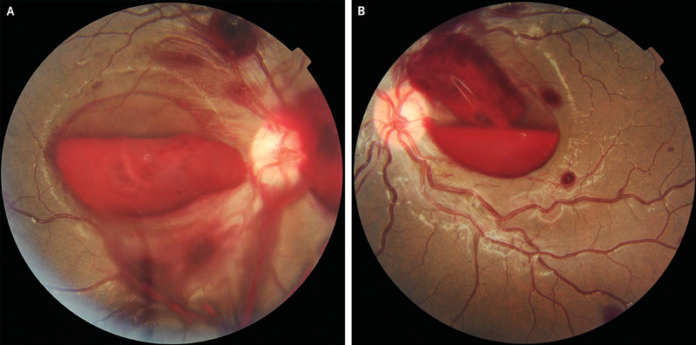
Retinal haemorrhage, a manifestation of leukaemia
Retinal haemorrhage is a common presenting complaint in leukaemia patients that presents at the initiation of or after therapy. It is a serious complication characterized by pathological infiltrates, hyperviscosity, thrombocytopenia and secondary anaemia. Thus, early detection is crucial for its management. This case further highlights the importance of routine eye exams in leukemic patients.
Leukaemia is defined as a systemic cancer of the blood and blood-forming tissues affecting multiple organs. Leukaemia is further classified into acute myeloid leukaemia (AML), acute lymphoblastic leukaemia (ALL), chronic myeloid leukaemia (CML) and chronic lymphocytic leukaemia (CLL) based on the duration of symptoms and form of the abnormal leukocytes. The most common type of leukaemia that affects adults is AML which is a complex disorder that arises in the hematopoietic stem cells.
Interestingly, the impact of leukaemia can be directly observed on the eye. Previous studies have shown that both acute and chronic leukaemia have ocular involvement. Though, acute leukaemia is significantly more common. The ocular manifestations are either because of direct infiltration of the neoplastic cells or post-chemotherapy which can lead to thrombocytopenia or anaemia. Based on a similar mechanism, the retina can also be affected in leukemic patients, as with this case. البينجو
The term leukaemic retinopathy is also used to describe retinal manifestations of thrombocytopenia, anaemia and hyperviscosity. An estimate of 35.4% of patients with leukaemia present with leukemic retinopathy.
Case presentation
This article describes the case of a 14-year-old boy with acute lymphoblastic leukaemia diagnosed with retinal haemorrhage, secondary to leukaemia. The patient presented to the emergency department with a 2-week history of fatigue and fever and a 3-day history of blurry vision. He was under maintenance chemotherapy for his leukaemia. The patient had no past history of vision problems. This was the first time the patient had experienced blurred vision.
Doctors further referred the patient for a complete blood count which was significant for a decreased white cell count, haemoglobin level and platelet count. The physical examination and investigation findings were consistent with the diagnosis of retinal haemorrhage secondary to leukaemia. Retinal haemorrhages are a common manifestation of leukaemia and are oftentimes secondary to complications of therapy. In the case of leukaemia, it may be triggered by hyperviscosity, vessel damage, leukemic infiltration and coagulopathy. Whereas retinal haemorrhage may be triggered because of severe anaemia and thrombocytopenia. ربح مال حقيقي Treatment included broad-spectrum antimicrobials and transfusion of platelets and packed red cells. The patient was called back for a follow-up after 4 months and his visual acuity showed significant improvement in both eyes [1].
In many chronic leukaemia cases, patients are asymptomatic. Though some patients may present with splenomegaly, lymphadenopathy, thrombosis, bleeding, frequent infections, malaise, weight loss and fever. In some cases, chronic leukaemias may enter a blast phase and the clinical manifestations are similar to acute leukaemias.
Acute lymphoblastic leukaemia
Acute lymphoblastic leukaemia or acute lymphocytic leukaemia is a type of cancer that affects the blood and bone marrow. The bone marrow is a spongy tissue inside the bones where the blood cells are made. The term “acute” is used when the disease progresses rapidly and rather than mature ones, creates immature blood cells. Similarly, the word “lymphocytic” refers to the white blood cells that cancer affects. It is the most common type of cancer in children but can also affect adults. Similarly, the disease prognosis in adults is quite poor. However, with treatment, there is a good chance of cure in children.
The disease occurs when the bone marrow cells develop changes or mutations. The genetic material or DNA in the cells is responsible for instructing a cell on what to do. Normally, these instructions include telling the cells to grow at a set rate and die at the same time. However, in acute lymphocytic leukaemia, the cells continue to grow and divide because of the mutations. As a consequence, the blood cell production becomes out of control, and the bone marrow produces immature cells that develop into lymphoblasts (leukaemic white blood cells). The abnormal cells do not function properly and cause build-up and crowd out the healthy cells. Although it is not completely clear what causes these mutations in the DNA that can cause acute lymphocytic leukaemia. العاب القمار على الانترنت
References
- Rodrigues, G.R. and Mendonca, T.M., 2022. Retinal Hemorrhages in Leukemia. The New England journal of medicine, 386(19), p.e50.



